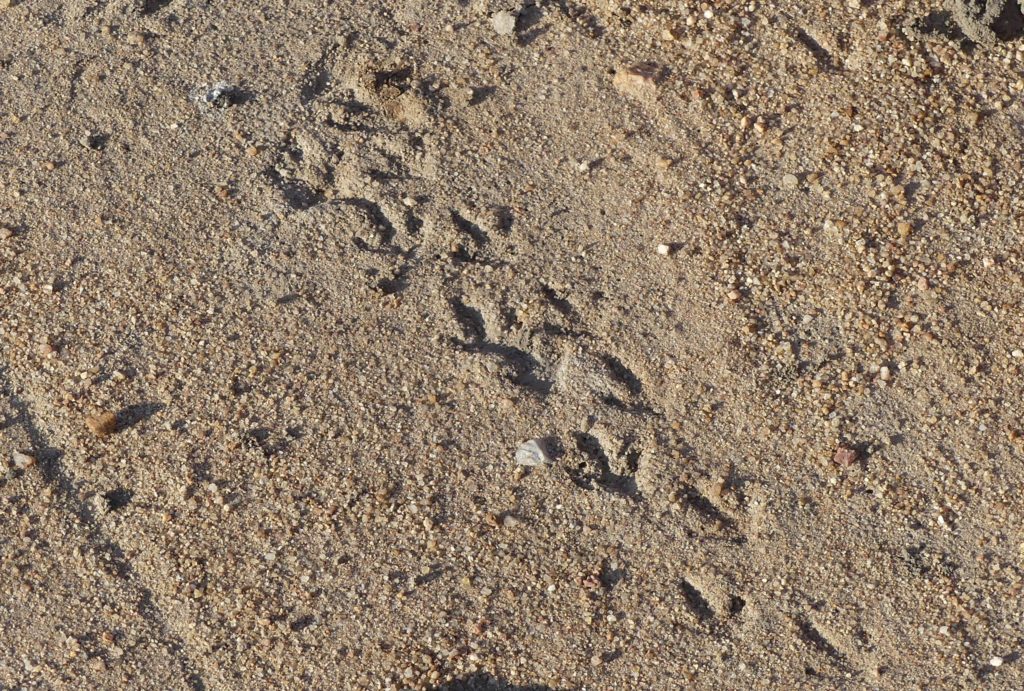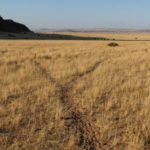The Double-banded Sandgrouse (Pterocles bicinctus) is commonly and colloquially called by its abbreviation ‘DBSG’ in Southern Africa. Its main distribution area is the savanna biome, especially Mopani Bushveld. There are three more species of sandgrouses in Southern Africa, all having distinctively different plumages but – essential for us – different drinking times of water.

Specific behaviors of Double-banded Sandgrouses
DBSGs prefer to stay in areas of short, seeding grasses speckled with bushes or other relatively open areas. They try to hide from their main predator, the Peregrine Falcon (Falco peregrinus), by camouflaging against his eyesight. Their color, shape, and movements are adapted for optimal hiding.

Plumage color in both sexes is inconspicuously speckled, streaked, and barred. They hide their shape with a body that looks relatively flat from above, and they avoid shadows by crouching and walking low to the ground. And their movement is unique for birds. They are shuffling very slowly forward with minimal and slow steps. That kind of slow, linear movement (without nicking the head or body), in combination with its colors and shape, lets it avoid many birds of prey. But walking that slow is not an advantage if moving across a road.

How Sandgrouse chicks are drinking
And there is another wonder of nature: DBSGs fly once a day to water for drinking. Males have specially adapted feathers at their breast, which can store water. They fly back to their chicks somewhere in the torched landscape at a speed of about 60 km/h, and this stored water does not evaporate significantly. Returning to the chicks, they squeeze out the transported water with their beaks from the breast feathers. Experiments in a zoo have shown that chicks can only drink water from cotton swaps but not from open water sources or regurgitation.
How Sandgrouses in flight can help to find water
To save energy and avoid birds of prey, DBSGs always fly straight from their point of roosting to the water source. Research has shown that the peak time they arrive at the water site is 16 minutes after sunset. Usually, between two and four Double-banded Sandgrouses arrive at the same time. The average remaining time at the water source is 28 minutes.
That means a person in the bush who is looking for water in a bushveld or scrubland savanna biome should look for one or two pairs of medium-sized birds, which are low and fast and fly in a straight line around sunset or shortly afterward. These will be DBSGs on their way to a good-sized, permanent, and open water source.
Water drinking times of all four Sandgrouse species in Southern Africa
The various sandgrouse species fly at different times to water. Still, only Double-banded sandgrouses and Yellow-throated sandgrouses can usually be seen, as the other two species fly during nighttime.
- Double-banded Sandgrouse (Pterocles bicinctus): 15′ after sunset
- Namaqua Sandgrouse (Pterocles Namaqua): 1 – 4 hours after sunset
- Burchell’s Sandgrouse (Pterocles burchelli): 3 – 5 hours after sunset
- Yellow-throated Sandgrouse (Pterocles gutturalis): early morning, always flies in flocks
Lessons learned for finding water with Double-banded Sandgrouses
- DBSG’s are flying either in pairs or two pairs very fast and low to the ground
- They fly in a straight line from the roosting point to the water
- They prefer clean, permanent water sources where they can stand at the bottom so that the water reaches up to mid-breast.
.




